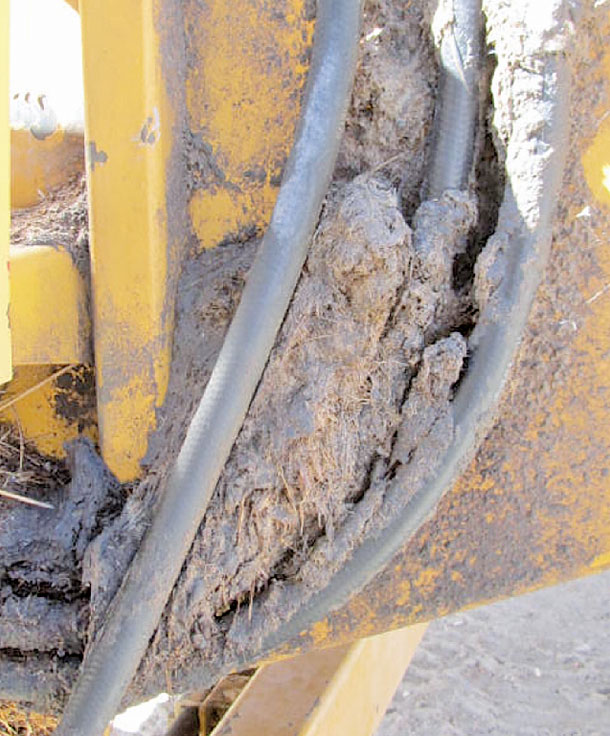Forage processors are an invaluable component of many of our cattle operations today. If you are feeding cattle in bunks or on the ground, forage processors add efficiency by reducing manpower, improving forage utilization and reducing waste.
Regardless of whether you are looking for a used processor or digging your own out of storage from the weed patch where you parked it last, there are some important areas to look at as you prepare for another feeding season.
Forage processors are fairly basic in function and design. Most of the components of a forage processor fall into one of four categories: body/frame, bale loader, bale process-rate system and flail/chopping system.
Many flail/chopping systems are powered mechanically from the power take-off (PTO) of the power source, commonly a tractor, and are comprised of shafts, universal joints and bearings. The bale loader and bale process-rate systems are powered hydraulically and are made up of hydraulic rams and motors, hoses, shafts, bushings and bearings.
Body or frame
Starting with the frame and body of the processor, remove forage chaff, oil and grease to look for cracks in the structural steel, welds and tinwork.

Bob Minor, metal fabricator in Salmon, Idaho, says, “Many cracks in the frame and tinwork can be repaired by welding flat plate or angle iron of the same gauge, or heavier, over the broken area.”
As you work your way around the processor, look for areas of stress and wear to the bale loader system. This is comprised of a frame with arms to cradle and lift the bale, a hydraulic ram and a pivot point.
Minor says, “One of the most common repairs I make is to the bale loader frame. Sometimes operators attempt to load bales that have frozen to the ground. Eventually, this will break the welds and frame where the load ram attaches to the main body.
If the person loading the processor catches this quick enough, I can usually repair this by reinforcing the frame with new steel plate and reattaching the ram. But if the driver does not see this problem in time, it can twist the main frame and bend the piston of the load ram.”
Having experienced this myself in the fall and spring, when the ground thaws during the day and re-freezes at night, I have remedied this problem by allowing a couple of feet between bales when I lay out several days’ worth of feed on the ground. This allows the operator of the processor to push the bale, breaking it loose from the frozen ground before attempting to lift it into the tub of the processor.
Bale loader
After checking the frame of the bale loader, check the hydraulic ram and hoses for leaks. Leaking rams can be rehabbed with new seal kits, and the hoses and fittings are easily replaced.
Next, look at the pivot points. These are generally a simple greased-bushing system with a pin. Check for excessive wear. If you find excessive wear, replace the bushing and pins. To prevent excessive wear in the future, grease the pivot points at the same time you grease the rest of the machine.
Process-rate system
Move on to the bale process-rate system. This system is powered by a hydraulic motor and allows the operator to control the direction and speed the bale travels over the flail. Depending on the manufacture and model of the processor, this system is comprised of cleated drums or a chain and table.
Both systems have shafts and bearings and are powered by a hydraulic motor. Remove any forage chaff, oil and grease from the motor and hoses and look for oil leaks. A large deposit of forage chaff and dirt can be an indication of an oil leak. Replace any leaking hoses or fittings.
Rob Jensen, of Mobile Services in Lemhi, Idaho, says, “It’s fairly simple to rebuild the hydraulic motors. Just be careful to make sure the shaft isn’t scored before you replace the seals. If you can feel a score line in the shaft with your finger, replace the shaft. If you replace the seals in the motor without replacing a bad shaft, the new seals won’t last long.”
Next, verify the seals in the bearings of the feed system are intact. If all of the seals are intact, and the bearings do not show obvious signs of failure, run the processor for a few minutes. Shut the machine off and feel all of the bearings in the feed system for heat. If any bearings are too hot to touch, replace.
The forage processor we use has a feed table and large chain system that rolls the bale over the flail drum, allowing the machine to feed either round or square bales. These systems utilize four flat nylon straps (2 inches wide) bolted to the top of the table under the chain.
These straps allow the chain to travel freely over the table while carrying the weight of the bale, preventing damage to the table and chain. Unfortunately, the combination of constant wear, sunlight and oxygen cause these straps to crack and break over time. Fortunately, they are cheap and easy to replace. If your processor has this system, check for cracked or missing straps and replace.
Flail/chopping system
The last major component of the forage processor to review is the flail/chopping system. While these systems are mechanically powered and simple in design, they are made up of universal joints, telescopic drive shafts, bearings and the flail/chopper. Whether you are viewing a used machine for purchase or servicing your own, give special attention to the components of this system.
Service of the PTO of forage processors is often neglected during the busy feeding season. Carefully check the condition of the universal joints and telescopic parts of the PTO shaft. The universal joints should feel tight with no slop. The telescopic parts of the shaft should be snug. You should not feel any movement when rotating the two halves of a shaft in opposite directions.
When servicing my processor after a period of non-use, I have found it helpful to break down the telescopic part of the PTO shaft and apply a liberal coat of a good lubricant/cleaner to strip the old, partially solidified dirt and grease from the two halves. I also apply this lubricant/cleaner to the PTO shaft of the tractor and the female coupler of the PTO shaft of the processor.
In order to effectively grease the universal joints and telescopic parts of the PTO shaft on my processor, it is much easier to detach the shaft from the tractor. By keeping these parts well lubricated and free of solidified dirt and grease, I can remove the PTO from the tractor easily on cold days.
When you reach the flail/chopper tube, be sure to check the main bearings on each end of the shaft that runs through the center of the tube. As the flail/chopper becomes wrapped with used twine or net wrap, it pushes this twine and net wrap out past the wall of the tub and builds around the bearings on the ends of the shaft.
This twine will begin to hold heat around the bearings and can eventually lead to failure. Check the condition of these bearings and replace if necessary.
Once you have completed this inspection/service, try to plan on servicing the moving parts of the machine and removing twine from the flail/chopper on a regular basis to prolong the working life of the processor.
Ed Snook, owner of Snook Ranch in Salmon, Idaho, says, “It’s easiest to keep the twine cleaned out of the processor if you don’t let it build up a lot. A couple inches around the flail is no big deal, but if it gets full, it can be a big job.”
Use an electric hot knife, constructed much like an electric branding iron, to safely and effectively melt through the twine or net wrap. You can purchase an electric hot knife at most farm and ranch supply stores. ![]()
PHOTO 1: An electric hot knife, much like an electric branding iron, cuts through twine and net wrap safely and easily.
PHOTO 2: Hay chaff has collected around a hydraulic oil leak at the flow control valve.

-
Michael J. Thomas
- Freelancer from Idaho
- Email Michael J. Thomas








